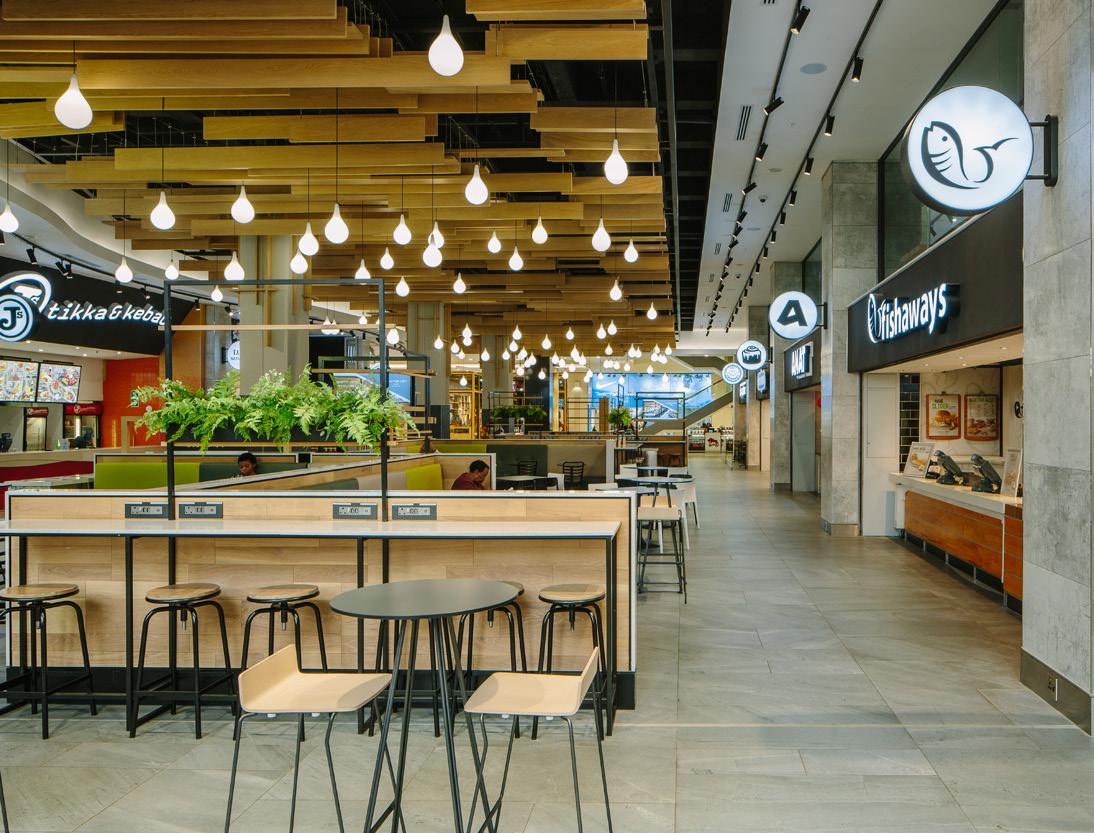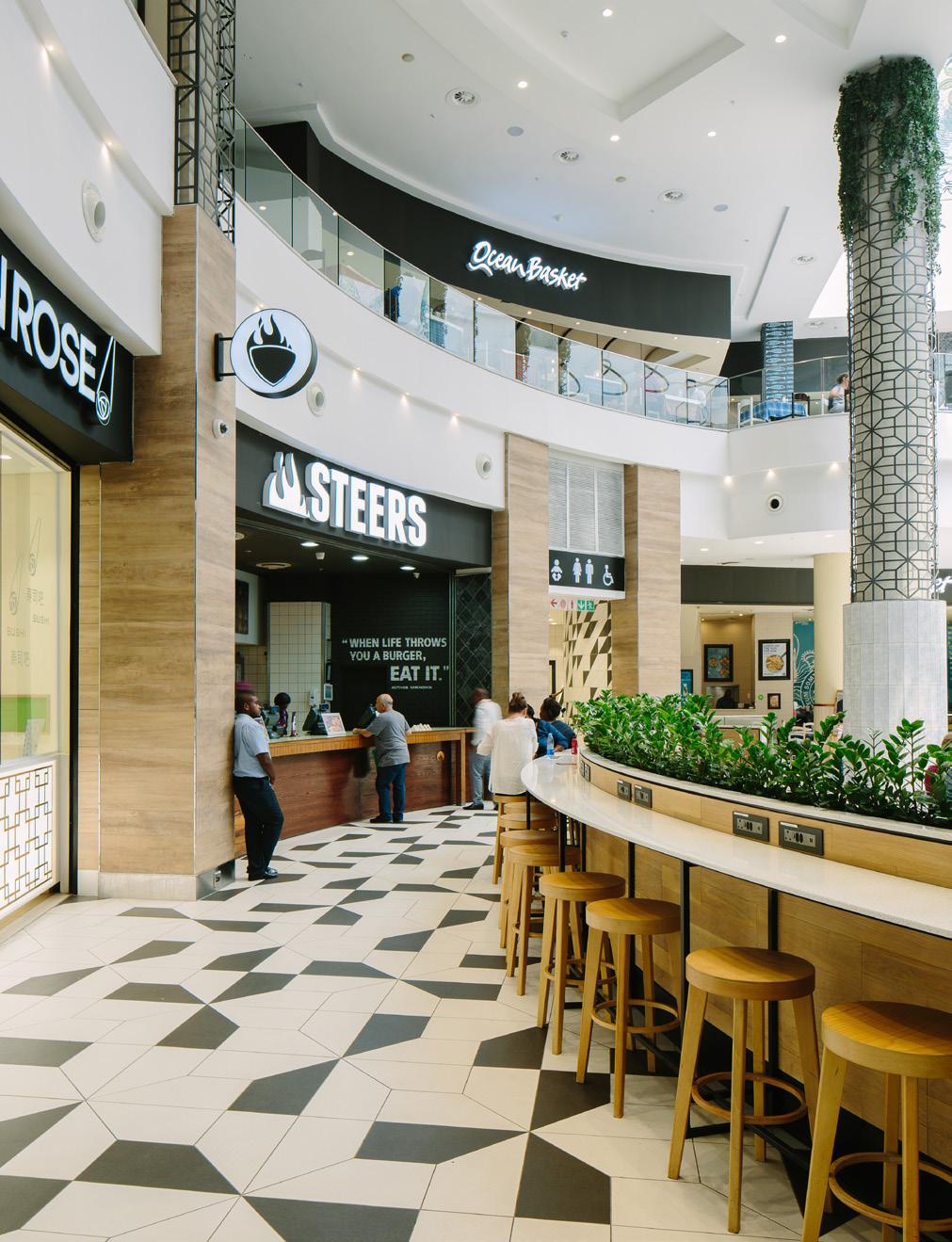
4 minute read
The evolution of a mall
Although Sandton City is one of the oldest shopping centres in South Africa, it is also one of the most iconic. Built in 1972 and designed by MDS Architecture, the building’s ability to continue to claim “firsts” after so many years is remarkable.

The major refurbishment of the Sandton City food court in 2018 included a new green material ETFE rooflight to enhance natural daylight in the double-volume space.
Tia Kanakakis, a partner at MDS Architecture, says that the owners, Liberty Group Limited, Pareto Limited and Liberty Two Degrees Proprietary Limited, are to be commended for their commitment to staying ahead of trends. She says that they take a long-term strategic approach with their design partners. As a result, several refurbishments, extensions and innovations have been designed over the years by the same architects that originally designed the shopping centre.
EXPERIENTIAL SHOPPING IN RECONFIGURED LOWER LEVEL, FOOD COURT AND CHECKERS COURT
As the retail environment changes and national tenants reduce the size of their stores, new approaches are required to support sustained occupancy for shopping centre owners. The reduction in size of Sandton City’s Checkers Hyper on its lower level created residual retail space. To counter this, the court was expanded to ensure a larger promotional and activation space and four new tenants, including a baby care lounge. In addition, space was created at the delivery level for a new waste management area, which processes all wet waste generated by Sandton City through a composter.
“The new tenants adjacent to the court represent flagship stores with innovative concepts. Among these are Sportscene, My Cotton Tree and Wimpy, which unveils its new look concept,” says Kanakakis. A storage facility, Storage Genie, was included at the lower level, responding to a demand for storage in Sandton’s CBD.
The new Checkers Hyper concept store, which opened in October 2019, promises to change the way people shop in a supermarket. It incorporates seven new experiences, such as a chocolatier, handmade pizzas baked in an in-store pizza oven, a sushi bar, temperature-controlled wine tasting room, and in-store access to well-known brands like Kauai and SCHOON.
FAMILY FUN
The cinema level was completely reimagined and refurbished, and was completed in March 2018 as an inviting space for families. A kid’s zone was introduced, complete with slides into the Hamley’s toy store, jungle gyms and a foyer where children can play. Using the iPad as its inspiration, pop art design visuals were incorporated against a fresh white background.

The new Checkers Hyper concept store re-envisions the way people shop, incorporating in-store access to other brands and experiences.

The food district now incorporates three types of seating with tables and chairs, bar counters and banquet seating.

Pop art design visuals were incorporated against a fresh white background on the cinema level.
FOOD COURT
Sandton City’s 17-year-old food court also underwent a major refurbishment in 2018 and was subsequently renamed the Food District. Says Kanakakis, “The refurbishment comprised changes over three levels. Our design intent was to create a bespoke food district with its own unique identity in the centre by using an artisanal monochromatic colour scheme, introducing unique features and services for the user.”
The food district incorporates three types of seating with tables and chairs, bar counter and banquet seating in new configurations, increasing the existing 270 seats to 450. The existing rooflight was replaced with a new green material ETFE rooflight to enhance natural daylight in the double-volume space. All existing floor finishes, wall finishes, demising piers, ceilings in the public mall seating area, ablution blocks, baby care rooms and parent/child facilities were refurbished.

The design of the new Food District was enhanced with timber elements, hanging silk plants and potted natural plants.
A special device-charging station provides free power and data points in the seating area for shoppers, charged from a newly built renewable power source (PV solar panels were installed on the roof). Kanakakis says that the project did not include any changes to existing trading tenants other than the signage changes, but this was a dramatic departure for brands who needed to use their own designs displayed in illuminated white against a dark charcoal background. Lollipop signs, erected perpendicular to the tenant’s premises, provide further interest. The design was enhanced with timber elements, hanging silk plants and potted natural plants.
All work was completed at night over eight months while the food district remained fully operational. Many of the existing tenants refurbished their stores to align with the new design, even though it was not a requirement.

Above: The artisanal monochromatic colour scheme gives the food district its own unique identity.
Existing materials and elements in the food district were carefully removed and donated to nominated social upliftment projects. Waste recycling was introduced in the public seating areas, as well as for the distribution of food tenants’ own waste.
WHAT’S NEXT?
Kanakakis says that Sandton City shoppers can expect more innovative experiences into the future as it’s forward-thinking owners tap into their trusted professionals to stay ahead of international retail trends. “Sandton City constantly evolves to ensure that the shopping centre maintains its reputation as a pioneering and inventive asset,” she concludes.





